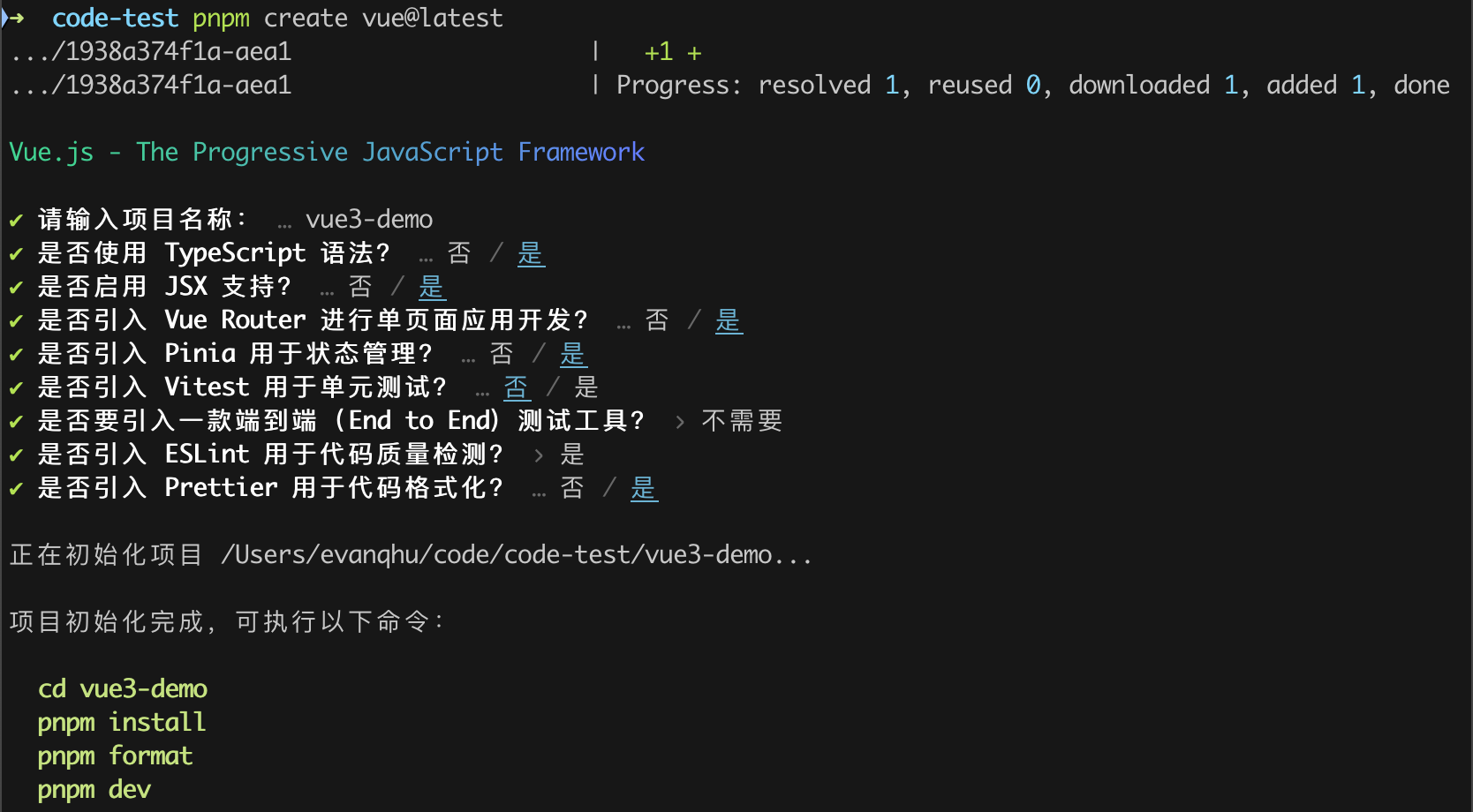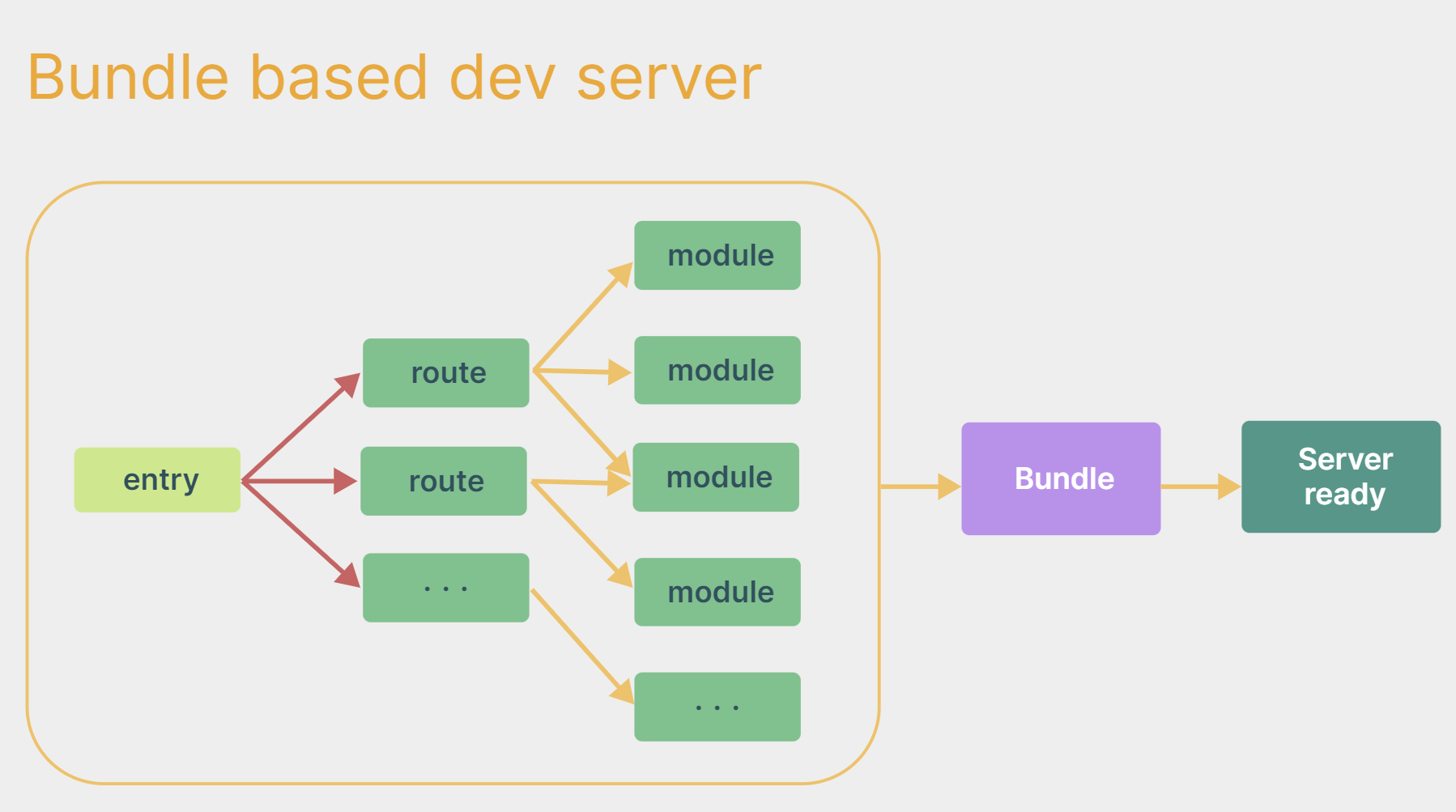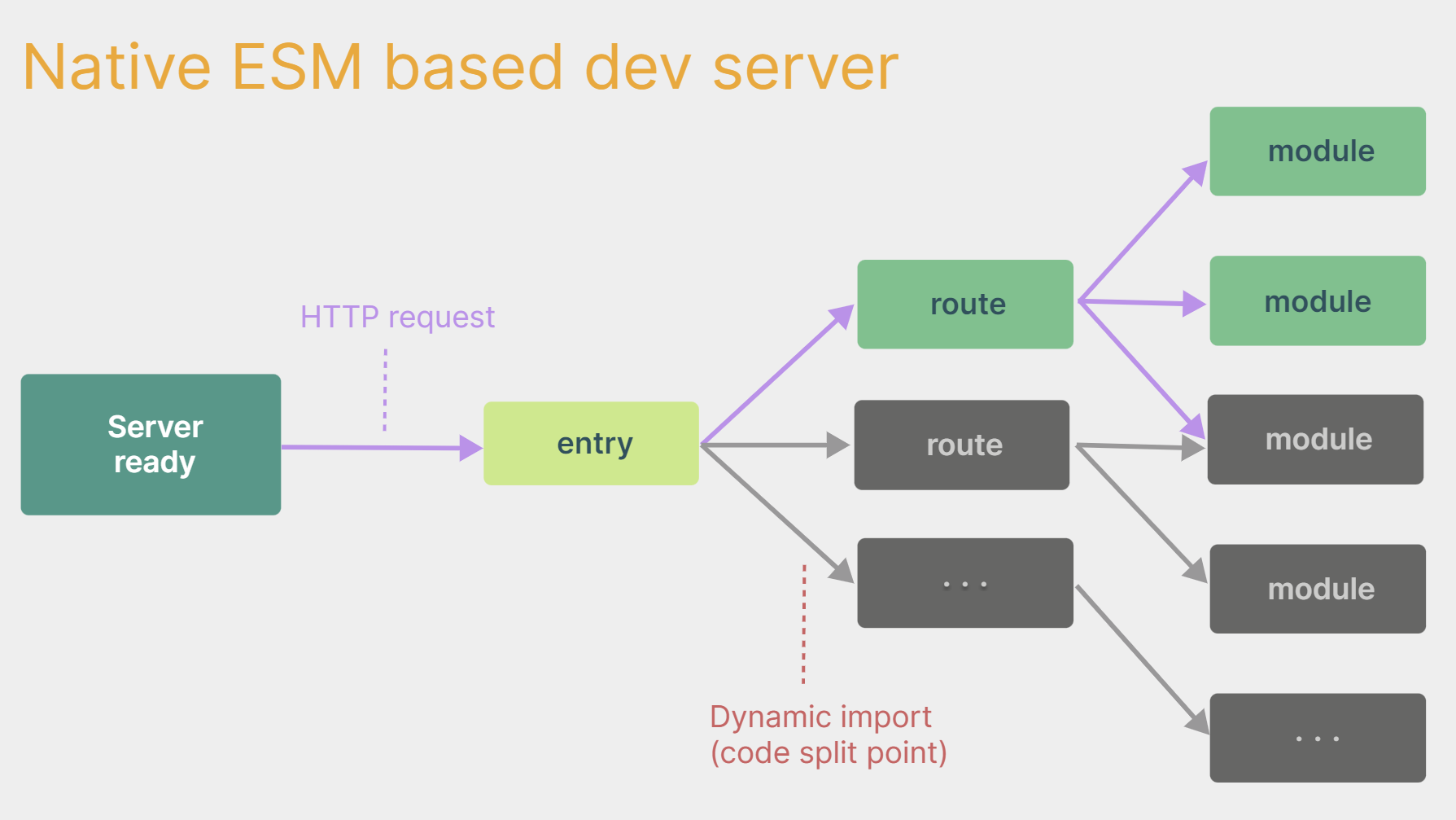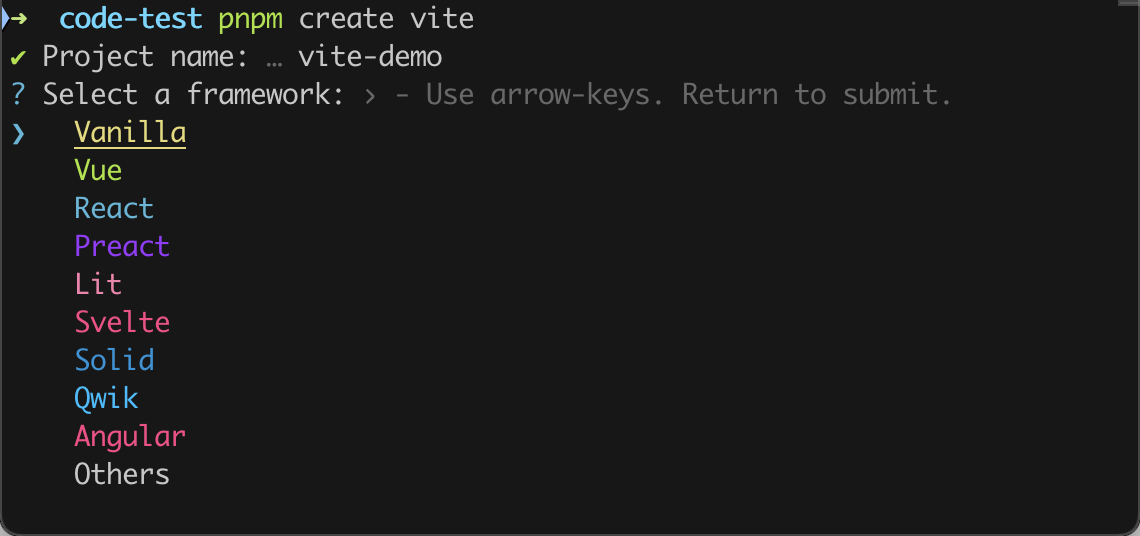Vue 3
01 Vue 3 简介
源码的升级
使用
Proxy代替defineProperty实现响应式重写虚拟
DOM的实现和Tree-Shaking
拥抱 TypeScript
Vue3 可以更好的支持 TypeScript
新的特性
Composition API (组合式 API)
setupref与reactivecomputed与watch......
新的内置组件
FragmentTeleportSuspense......
其他改变
新的生命周期钩子
data选项应始终被声明为一个函数移除
keyCode支持作为v-on的修饰符......
02 创建 Vue 3 工程
1️⃣ 基于 create-vue 创建
create-vue 是 Vue 官方的项目脚手架工具。你将会看到一些诸如 TypeScript 和测试支持之类的可选功能提示:
pnpm create vue@latest
2️⃣ 基于 create-vite 创建
Vite 是新一代前端构建工具,Vite 的优势如下:
- 轻量快速的热重载(
HMR),能实现极速的服务启动。 - 对
TypeScript、JSX、CSS等支持开箱即用。 - 真正的按需编译,不再等待整个应用编译完成。
webpack构建与Vite构建对比图如下:


create-vite 是 Vite 官方的项目脚手架工具。使用 Vite 创建项目时可以选择多种项目模板,包括 Vue、React、SSR 等等类型
## 执行创建命令
pnpm create vite
选择某个框架之后,还可以自定义模板,比如这里选择 Vue 框架,还可以通过 create-vue 来自定义模板,也可以选择 Nuxt 模板等

自己动手编写一个 App 组件
<template>
<div class="app">
<h1>你好啊!</h1>
</div>
</template>
<script lang="ts">
export default {
name: "App", // 组件名
};
</script>
<style></style>安装官方推荐的 VSCode 插件:Vue-Official
一个简单的效果
Vue3 向下兼容 Vue2 语法,且 Vue3 中的模板中可以没有根标签
<template>
<div class="person">
<h2>姓名:{{ name }}</h2>
<h2>年龄:{{ age }}</h2>
<button @click="changeName">修改名字</button>
<button @click="changeAge">年龄+1</button>
<button @click="showTel">点我查看联系方式</button>
</div>
</template>
<script lang="ts">
export default {
name: "App",
data() {
return {
name: "张三",
age: 18,
tel: "13888888888",
};
},
methods: {
changeName() {
this.name = "zhang-san";
},
changeAge() {
this.age += 1;
},
showTel() {
alert(this.tel);
},
},
};
</script>03 拉开序幕的 setup
1️⃣ setup 概述
setup 是 Vue3 中一个新的配置项,值是一个函数,它是 Composition API 表演的舞台,组件中所用到的数据、方法、计算属性、监视......等等,均配置在 setup 中。
setup函数返回值 (对象) 中的内容,可直接在模板中使用setup函数会在beforeCreate之前调用setup函数中访问this是undefined(因为它领先于所有生命周期钩子)
<template>
<div class="person">
<h2>姓名:{{ name }}</h2>
<h2>年龄:{{ age }}</h2>
<button @click="changeName">修改名字</button>
<button @click="changeAge">年龄+1</button>
</div>
</template>
<script lang="ts">
export default {
name: "Person",
setup() {
// 数据,原来写在 data 中(注意:此时的 name、age、tel 数据都不是响应式数据)
let name = "张三";
let age = 18;
// 方法,原来写在 methods 中
function changeName() {
name = "zhang-san"; //注意:此时这么修改 name 页面是不变化的
console.log(name);
}
function changeAge() {
age += 1; //注意:此时这么修改 age 页面是不变化的
console.log(age);
}
// 返回一个对象,对象中的内容,模板中可以直接使用
return { name, age, changeName, changeAge };
},
};
</script>2️⃣ setup 的返回值
- 若返回一个对象:则对象中的:属性、方法等,在模板中均可以直接使用 (最常使用)
- 若返回一个函数:则可以自定义渲染内容,代码如下:
setup() {
return () => '你好啊!'
}3️⃣ setup 与组合式 API
Vue2的配置(data、methods......)中可以访问到setup中的属性、方法- 但在
setup中不能访问到Vue2的配置(data、methods......) - 如果与
Vue2冲突,则setup优先
4️⃣ setup 语法糖
setup 函数有一个语法糖,这个语法糖,可以让我们把 setup 独立出去,代码如下
该
<script setup lang="ts">标签中的内容相当于 setup 函数的函数体,并且无需书写 return,其中定义的变量和方法会自动 return
<template>
<div class="person">
<h2>姓名:{{ name }}</h2>
<button @click="changName">修改名字</button>
</div>
</template>
<script lang="ts">
export default {
name: "Person",
};
</script>
<!-- 下面的写法是 setup 语法糖 -->
<script setup lang="ts">
let name = "张三";
function changName() {
name = "李四";
}
</script>扩展:上述代码,还需要编写一个不写 setup 的 script 标签,去指定组件名字,比较麻烦,我们可以借助Vite 中的插件简化
- 安装插件
pnpm i vite-plugin-vue-setup-extend -D- 在
vite.config.ts中配置插件
import { defineConfig } from "vite";
import VueSetupExtend from "vite-plugin-vue-setup-extend";
export default defineConfig({
plugins: [VueSetupExtend()],
});- 在语法糖标签中书写 name 属性
<script setup lang="ts" name="Person">
import { ref } from "vue";
</script>04 ref 基本类型
- **作用:**定义响应式变量
- 语法:
const xxx = ref(初始值) - **返回值:**一个
RefImpl的实例对象,简称ref对象或ref,ref对象的value属性是响应式的 - 注意点:
JS中操作数据需要:xxx.value,但模板中不需要.value,直接使用即可- 对于
const name = ref('张三')来说,name不是响应式的,name.value是响应式的
<template>
<div class="person">
<h2>姓名:{{ name }}</h2>
<h2>年龄:{{ age }}</h2>
<button @click="changeName">修改名字</button>
<button @click="changeAge">年龄+1</button>
<button @click="showTel">点我查看联系方式</button>
</div>
</template>
<script setup lang="ts" name="Person">
import { ref } from "vue";
// name 和 age 是一个 RefImpl 的实例对象,简称 ref 对象,它们的 value 属性是响应式的
const name = ref("张三");
const age = ref(18);
// tel 就是一个普通的字符串,不是响应式的
const tel = "13888888888";
function changeName() {
// JS 中操作 ref 对象时候需要 .value
name.value = "李四";
console.log(name.value);
// 注意:name 不是响应式的,name.value 是响应式的,所以如下代码并不会引起页面的更新。
// name = ref('zhang-san')
}
function changeAge() {
age.value += 1;
console.log(age.value);
}
function showTel() {
alert(tel);
}
</script>05 reactive 对象类型
- 作用:定义一个响应式对象(基本类型不要用它,要用
ref,否则报错) - 语法:
const 响应式对象 = reactive(源对象) - **返回值:**一个
Proxy的实例对象,简称:响应式对象 - 注意点:
reactive定义的响应式数据是“深层次”的
<template>
<div class="person">
<h2>汽车信息:一台{{ car.brand }}汽车,价值{{ car.price }}万</h2>
<h2>游戏列表:</h2>
<ul>
<li v-for="game in games" :key="game.id">{{ game.name }}</li>
</ul>
<h2>测试:{{ obj.a.b.c.d }}</h2>
<button @click="changeCarPrice">修改汽车价格</button>
<button @click="changeFirstGame">修改第一游戏</button>
<button @click="test">测试</button>
</div>
</template>
<script lang="ts" setup name="Person">
import { reactive } from "vue";
// 数据
const car = reactive({ brand: "奔驰", price: 100 });
const games = reactive([
{ id: "abcd01", name: "英雄联盟" },
{ id: "abcd02", name: "王者荣耀" },
{ id: "abcd03", name: "原神" },
]);
const obj = reactive({
a: {
b: {
c: {
d: 666,
},
},
},
});
function changeCarPrice() {
car.price += 10;
}
function changeFirstGame() {
games[0].name = "流星蝴蝶剑";
}
function test() {
obj.a.b.c.d = 999;
}
</script>06 ref 对象类型
- 其实
ref接收的数据可以是:基本类型、对象类型 - 若
ref接收的是对象类型,内部其实也是调用了reactive函数
<template>
<div class="person">
<h2>汽车信息:一台{{ car.brand }}汽车,价值{{ car.price }}万</h2>
<h2>游戏列表:</h2>
<ul>
<li v-for="g in games" :key="g.id">{{ g.name }}</li>
</ul>
<h2>测试:{{ obj.a.b.c.d }}</h2>
<button @click="changeCarPrice">修改汽车价格</button>
<button @click="changeFirstGame">修改第一游戏</button>
<button @click="test">测试</button>
</div>
</template>
<script lang="ts" setup name="Person">
import { ref } from "vue";
// 数据
const car = ref({ brand: "奔驰", price: 100 });
const games = ref([
{ id: "ahsgdyfa01", name: "英雄联盟" },
{ id: "ahsgdyfa02", name: "王者荣耀" },
{ id: "ahsgdyfa03", name: "原神" },
]);
const obj = ref({
a: {
b: {
c: {
d: 666,
},
},
},
});
console.log(car);
function changeCarPrice() {
car.value.price += 10;
}
function changeFirstGame() {
games.value[0].name = "流星蝴蝶剑";
}
function test() {
obj.value.a.b.c.d = 999;
}
</script>07 ref 对比 reactive
用法
ref用来定义:基本类型数据、对象类型数据reactive用来定义:对象类型数据
区别
ref创建的变量必须使用.value(可以使用插件自动添加.value)reactive重新分配一个新对象,会失去响应式 (可以使用Object.assign去整体替换)
let car = reactive({ brand: "奔驰", price: 100 });
// car = { brand: '大众', price: 10 } // 这样操作会失去响应式
Object.assign(car, { brand: "大众", price: 10 }); // 正确做法使用原则
- 若需要一个基本类型的响应式数据,必须使用
ref - 若需要一个响应式对象,层级不深,
ref、reactive都可以 - 若需要一个响应式对象,且层级较深,推荐使用
reactive
08 toRef 与 toRefs
- 作用:将一个响应式对象中的每一个属性,转换为
ref对象 toRefs与toRef功能一致,但toRefs可以批量转换- 改变
nameagegender时,person中的相应属性值也会被改变toRef:创建的 ref 与其源属性保持同步:改变源属性的值将更新 ref 的值,反之亦然
<script lang="ts" setup name="Person">
import { reactive, toRefs, toRef } from "vue";
const person = reactive({ name: "张三", age: 18, gender: "男" });
// 通过 toRefs 将 person 对象中的 n 个属性批量取出,且依然保持响应式的能力
const { name, age } = toRefs(person);
// 通过 toRef 将 person 对象中的 gender 属性取出,且依然保持响应式的能力
const gender = toRef(person, "gender");
</script>09 computed
作用:根据已有数据计算出新数据(和 Vue2 中的 computed 作用一致)
参数:一个 getter 函数
返回值:一个计算数属性 ref
<template>
<div class="person">
姓:<input type="text" v-model="firstName" /> <br />
名:<input type="text" v-model="lastName" /> <br />
全名:<span>{{ fullName }}</span> <br />
<button @click="changeFullName">全名改为:li-si</button>
</div>
</template>
<script setup lang="ts" name="App">
import { ref, computed } from "vue";
const firstName = ref("zhang");
const lastName = ref("san");
// 计算属性——只读取,不修改
/* const fullName = computed(() => {
return firstName.value + '-' + lastName.value
}) */
// 计算属性——既读取又修改
const fullName = computed({
// 读取
get() {
return firstName.value + "-" + lastName.value;
},
// 修改
set(val) {
console.log("有人修改了fullName", val);
firstName.value = val.split("-")[0];
lastName.value = val.split("-")[1];
},
});
function changeFullName() {
fullName.value = "li-si";
}
</script>10 watch
- 作用:监视数据的变化(和
Vue2中的watch作用一致) watch函数的返回值是一个函数,调用该函数可以停止监视- 特点:
Vue3中的watch只能监视以下四种数据ref定义的数据reactive定义的数据- 函数返回一个值 (能返回一个值的函数,也叫
getter函数) - 一个包含上述内容的数组
我们在 Vue3 中使用 watch 的时候,通常会遇到以下 5 种情况
1️⃣ 情况一
监视 ref 定义的【基本类型】数据:直接写数据名,监视的是其 value 值的改变
<template>
<div class="person">
<h1>情况一:监视 ref 定义的基本类型数据</h1>
<h2>当前求和为:{{ sum }}</h2>
<button @click="changeSum">点我 sum+1</button>
</div>
</template>
<script lang="ts" setup name="Person">
import { ref, watch } from "vue";
const sum = ref(0);
function changeSum() {
sum.value += 1;
}
// 监视 ref 定义的基本类型数据
const stopWatch = watch(sum, (newValue, oldValue) => {
console.log("sum变化了", newValue, oldValue);
if (newValue >= 10) {
stopWatch();
}
});
</script>2️⃣ 情况二
监视 ref 定义的【对象类型】数据:直接写数据名,监视的是地址值,根据需求可开启深度监视
- 直接写数据名,监视的是对象的地址值
- 若想监视对象内部的数据,要手动开启深度监视
<template>
<div class="person">
<h1>情况二:监视 ref 定义的对象类型数据</h1>
<h2>姓名:{{ person.name }}</h2>
<h2>年龄:{{ person.age }}</h2>
<button @click="changeName">修改名字</button>
<button @click="changeAge">修改年龄</button>
<button @click="changePerson">修改整个人</button>
</div>
</template>
<script lang="ts" setup name="Person">
import { ref, watch } from "vue";
const person = ref({
name: "张三",
age: 18,
});
function changeName() {
person.name += "~";
}
function changeAge() {
person.value.age += 1;
}
function changePerson() {
person.value = { name: "李四", age: 90 };
}
// 监视 ref 定义的对象类型数据,监视的是对象的地址值,若想监视内部属性的变化,需要开启深度监视
// watch 的第一个参数是:被监视的数据
// watch 的第二个参数是:监视的回调
// watch 的第三个参数是:配置对象(deep、immediate 等等.....)
watch(
person,
(newValue, oldValue) => {
console.log("person变化了", newValue, oldValue);
},
{ deep: true }
);
</script>开启深度监视后,若修改的是
ref定义的对象中的属性(对象.value 没有发生变化),newValue和oldValue都是新值,因为它们是同一个对象若修改整个
ref定义的对象,newValue是新值,oldValue是旧值,因为不是同一个对象了
3️⃣ 情况三
监视 reactive 定义的【对象类型】数据:直接写数据名,默认开启了深度监视
<template>
<div class="person">
<h1>情况三:监视 reactive 定义的对象类型数据</h1>
<h2>姓名:{{ person.name }}</h2>
<h2>年龄:{{ person.age }}</h2>
<button @click="changeName">修改名字</button>
<button @click="changeAge">修改年龄</button>
<button @click="changePerson">修改整个人</button>
</div>
</template>
<script lang="ts" setup name="Person">
import { reactive, watch } from "vue";
const person = reactive({
name: "张三",
age: 18,
});
function changeName() {
person.name += "~";
}
function changeAge() {
person.age += 1;
}
function changePerson() {
Object.assign(person, { name: "李四", age: 80 });
}
watch(person, (newValue, oldValue) => {
// newValue 和 oldValue 是相同的
console.log("person变化了", newValue, oldValue);
});
</script>4️⃣ 情况四
监视 ref 或 reactive 定义的【对象类型】数据中的【某个属性】,建议都写成 getter 函数
- 若该属性值是基本类型,需要写成
getter函数形式 - 若该属性值是对象类型,可直接监视,也可写成函数,建议写成函数
<template>
<div class="person">
<h1>情况四:监视 ref 或 reactive 定义的对象类型数据中的某个属性</h1>
<h2>姓名:{{ person.name }}</h2>
<h2>年龄:{{ person.age }}</h2>
<h2>汽车:{{ person.car.c1 }}、{{ person.car.c2 }}</h2>
<button @click="changeName">修改名字</button>
<button @click="changeAge">修改年龄</button>
<button @click="changeC1">修改第一台车</button>
<button @click="changeC2">修改第二台车</button>
<button @click="changeCar">修改整个车</button>
</div>
</template>
<script lang="ts" setup name="Person">
import { reactive, watch } from "vue";
const person = reactive({
name: "张三",
age: 18,
car: { c1: "奔驰", c2: "宝马" },
});
function changeName() {
person.name += "~";
}
function changeAge() {
person.age += 1;
}
function changeC1() {
person.car.c1 = "奥迪";
}
function changeC2() {
person.car.c2 = "大众";
}
function changeCar() {
person.car = { c1: "雅迪", c2: "爱玛" };
}
// 监视响应式对象中的某个属性,且该属性是基本类型的,要写成函数式
watch(
() => person.name,
(newValue, oldValue) => {
console.log("person.name变化了", newValue, oldValue);
}
);
// 监视响应式对象中的某个属性,且该属性是对象类型的,可以直接写,也能写函数,更推荐写函数并配合深度监视
watch(
() => person.car,
(newValue, oldValue) => {
console.log("person.car变化了", newValue, oldValue);
},
{ deep: true }
);
</script>如果直接监视
person.car,修改 car 里面的属性时可以被监视到,但是直接通过 person.car = xxx 时,会监视不到,因为这里的 person.car 相当于一个 reactive 定义的响应式对象,要使用 Object.assign 才行如果写成函数式,监视
() => person.car,则 car 的属性的变化不会被监视到,只有修改整个 car 才会被监视到;如果需要同时监视 car 内部属性的变化,需要开启深度监视 (相当于把() => person.car变成了一个 ref 定义的响应式对象)
5️⃣ 情况五
监视上述的多个数据
<template>
<div class="person">
<h1>情况五:监视上述的多个数据</h1>
<h2>姓名:{{ person.name }}</h2>
<h2>年龄:{{ person.age }}</h2>
<h2>汽车:{{ person.car.c1 }}、{{ person.car.c2 }}</h2>
<button @click="changeName">修改名字</button>
<button @click="changeAge">修改年龄</button>
<button @click="changeC1">修改第一台车</button>
<button @click="changeC2">修改第二台车</button>
<button @click="changeCar">修改整个车</button>
</div>
</template>
<script lang="ts" setup name="Person">
import {r eactive, watch } from 'vue'
const person = reactive({
name:'张三',
age:18,
car: { c1: '奔驰', c2: '宝马' }
})
function changeName() { person.name += '~' }
function changeAge() { person.age += 1 }
function changeC1() { person.car.c1 = '奥迪' }
function changeC2() { person.car.c2 = '大众' }
function changeCar() { person.car = { c1: '雅迪', c2: '爱玛' } }
watch([() => person.name, person.car], (newValue, oldValue) => {
console.log('person.car变化了', newValue, oldValue)
}, { deep: true })
</script>11 watchEffect
立即运行一个函数,同时响应式地追踪其依赖,并在依赖更改时重新执行该函数
watch 对比 watchEffect
都能监听响应式数据的变化,不同的是监听数据变化的方式不同
watch要明确指出监视的数据watchEffect不用明确指出监视的数据(函数中用到哪些属性,那就监视哪些属性)
<template>
<div class="person">
<h1>需求:水温达到 50,或水位达到 20,则联系服务器</h1>
<h2 id="demo">水温:{{ temp }}</h2>
<h2>水位:{{ height }}</h2>
<button @click="changePrice">水温+1</button>
<button @click="changeSum">水位+10</button>
</div>
</template>
<script lang="ts" setup name="Person">
import { ref, watch, watchEffect } from "vue";
const temp = ref(0);
const height = ref(0);
function changePrice() {
temp.value += 10;
}
function changeSum() {
height.value += 1;
}
// 1. 用 watch 实现,需要明确的指出要监视:temp、height
watch([temp, height], (value) => {
// 从 value 中获取最新的 temp 值、height 值
const [newTemp, newHeight] = value;
if (newTemp >= 50 || newHeight >= 20) {
console.log("联系服务器");
}
});
// 2. 用 watchEffect 实现,不用明确指出要监视谁
const stopWtach = watchEffect(() => {
if (temp.value >= 50 || height.value >= 20) {
console.log("联系服务器");
}
// 水温达到 100,或水位达到 50,取消监视
if (temp.value === 100 || height.value === 50) {
console.log("取消监视");
stopWtach();
}
});
</script>12 标签的 ref 属性
用于注册模板引用
- 用在普通
DOM标签上,获取的是DOM节点 - 用在组件标签上,获取的是子组件实例对象
1️⃣ 用在普通 DOM 标签上
<template>
<div class="person">
<h1 ref="title1">前端</h1>
<button @click="showLog">点我打印内容</button>
</div>
</template>
<script lang="ts" setup name="Person">
import { ref } from "vue";
// 创建 ref 容器,用于存储 ref 标记的内容
const title1 = ref();
function showLog() {
console.log(title1.value);
}
</script>2️⃣ 用在组件标签上
<!-- 父组件 App.vue -->
<template>
<Person ref="ren" />
<button @click="test">测试</button>
</template>
<script lang="ts" setup name="App">
import Person from "./components/Person.vue";
import { ref } from "vue";
// 创建 ref 容器,用于存储 ref 标记的内容
const ren = ref();
function test() {
console.log(ren.value.name);
console.log(ren.value.age);
}
</script>
<!-- 子组件 Person.vue 中要使用 defineExpose 宏函数暴露内容 -->
<script lang="ts" setup name="Person">
import { ref } from "vue";
const name = ref("张三");
const age = ref(18);
// 使用 defineExpose 将组件中的数据交给外部
defineExpose({ name, age });
</script>13 props
通过 defineProps<泛型>() 函数来定义组件接收到的 props
1️⃣ defineProps() 函数接收的参数
- 参数可以是一个数组,表示多个 props;
const props = defineProps(["foo"]);- 参数可以是一个对象,该对象称为类型检查对象,对象中的属性表示接收到的 props,对象的值是用于验证传入 props 类型的构造函数,只能是 String,Number,Boolean 等,不能是 TS 定义的普通类型。TypeScript 类型只能用于编译时检查,而不能在运行时使用
const props = defineProps({
foo: String,
});2️⃣ defineProps() 函数的泛型 (大部分代码都是传的泛型,单独定义一个 Props 的接口类型)
可以通过泛型来限制 props 的类型
写了泛型之后,函数不能再传参数了,否则会报错
const props = defineProps<{
foo: string
bar?: number
}>()3️⃣ defineProps() 函数的返回值
- 函数的返回值是一个 Proxy 对象,相当于一个 reactive 定义的响应式对象
4️⃣ 代码示例
types.ts
// 定义一个接口,限制每个 Person 对象的格式
export interface IPerson {
id: string;
name: string;
age: number;
}
// 定义一个自定义类型 PersonList
export type PersonList = Array<IPerson>;父组件 App.vue
<!-- 父组件 App.vue -->
<template>
<Person :list="persons" />
</template>
<script lang="ts" setup name="App">
import Person from "@/components/Person.vue";
import { reactive } from "vue";
import { type PersonList } from "./types";
// reactive 定义数据时可以传泛型
const persons = reactive<PersonList>([
{ id: "e98219e12", name: "张三", age: 18 },
{ id: "e98219e13", name: "李四", age: 19 },
{ id: "e98219e14", name: "王五", age: 20 },
]);
</script>子组件 Person.vue
<!-- 子组件 Person.vue -->
<template>
<div class="person">
<ul>
<li v-for="item in list" :key="item.id">{{ item.name }}--{{ item.age }}</li>
</ul>
</div>
</template>
<script lang="ts" setup name="Person">
import { defineProps } from "vue";
import { type PersonList } from "@/types"; // 这里加 type 是为了把值和类型规范区别开来
// 1. 仅接收
const props = defineProps(["list"]);
// 2. 接收+限制类型 (defineProps 可以传泛型,且传了泛型之后就不用给函数传递参数了)
defineProps<{ list: PersonList }>();
// 3. 接收+限制类型 (不用泛型,用运行时检查,但是值后面只能跟类型的构造函数,如 String,Number 等)
defineProps({
list: String, // 不能写 PersonList !!!!!!
});
// 3. 接收+限制类型+指定默认值+限制必要性
// 当默认值给了 list,相当于给 list 的类型添加了可选性,表示 list 可传可不传,无需再添加 ?
// 当给一个对象类型的 props 指定默认值时,要写成 getter 函数的形式,不能直接写一个对象
const props = withDefaults(defineProps<{ list: PersonList }>(), {
list: () => [{ id: "abcd01", name: "小猪佩奇", age: 18 }],
});
console.log(props);
</script>14 生命周期
Vue 组件实例在创建时要经历一系列的初始化步骤,在此过程中 Vue 会在合适的时机,调用特定的函数,从而让开发者有机会在特定阶段运行自己的代码,这些特定的函数统称为:生命周期钩子
生命周期整体分为四个阶段,分别是:创建、挂载、更新、销毁,每个阶段都有两个钩子,一前一后
Vue2 的生命周期
创建阶段:
beforeCreate、created挂载阶段:
beforeMount、mounted更新阶段:
beforeUpdate、updated销毁阶段:
beforeDestroy、destroyed
Vue3 的生命周期
创建阶段:
setup挂载阶段:
onBeforeMount、onMounted更新阶段:
onBeforeUpdate、onUpdated卸载阶段:
onBeforeUnmount、onUnmounted
常用的钩子:onMounted (挂载完毕)、onUpdated (更新完毕)、onBeforeUnmount (卸载之前)
<template>
<div class="person">
<h2>当前求和为:{{ sum }}</h2>
<button @click="changeSum">点我sum+1</button>
</div>
</template>
<!-- Vue3 写法 -->
<script lang="ts" setup name="Person">
import { ref, onBeforeMount, onMounted, onBeforeUpdate, onUpdated, onBeforeUnmount, onUnmounted } from "vue";
const sum = ref(0);
// 方法
function changeSum() {
sum.value += 1;
}
console.log("setup"); // 创建
// 生命周期钩子
onBeforeMount(() => {
console.log("挂载之前");
});
onMounted(() => {
console.log("挂载完毕");
});
onBeforeUpdate(() => {
console.log("更新之前");
});
onUpdated(() => {
console.log("更新完毕");
});
onBeforeUnmount(() => {
console.log("卸载之前");
});
onUnmounted(() => {
console.log("卸载完毕");
});
</script>15 自定义 hook
hook 本质是一个函数,把 setup 函数中使用的 Composition API 进行了封装,类似于 Vue2 中的 mixin
自定义 hook 的优势:复用代码,让 setup 中的逻辑更清楚易懂。一般使用 useXxx 命名
// useSum.ts
import { ref, onMounted } from "vue";
export default function useSum() {
const sum = ref(0);
const increment = () => {
sum.value += 1;
};
const decrement = () => {
sum.value -= 1;
};
onMounted(() => {
increment();
});
// 向外部暴露数据
return { sum, increment, decrement };
}// useDog.ts
import { reactive, onMounted } from 'vue'
import axios, { AxiosError } from 'axios'
export default function useDog() {
const dogList = reactive<string[]>([])
async function getDog () {
try {
const { data } = await axios.get('https://dog.ceo/api/breed/pembroke/images/random')
dogList.push(data.message)
} catch (error) {
const err = <AxiosError>error
console.log(err.message)
}
}
onMounted(()=>{
getDog()
})
// 向外部暴露数据
return { dogList, getDog }
}组件中具体使用这两个自定义 hooks :
<template>
<h2>当前求和为:{{ sum }}</h2>
<button @click="increment">点我+1</button>
<button @click="decrement">点我-1</button>
<hr />
<img v-for="(u, index) in dogList.urlList" :key="index" :src="(u as string)" />
<span v-show="dogList.isLoading">加载中......</span><br />
<button @click="getDog">再来一只狗</button>
</template>
<script lang="ts" setup name="App">
import useSum from "./hooks/useSum";
import useDog from "./hooks/useDog";
const { sum, increment, decrement } = useSum();
const { dogList, getDog } = useDog();
</script>16 组件通信
Vue3 组件通信和 Vue2 的区别
- 移除事件总线,使用
mitt代替
Vuex换成了Pinia- 把
.sync优化到了v-model里面了 - 把
$listeners所有的东西,合并到$attrs中了 $children被砍掉了
props
props 是使用频率最高的一种通信方式,常用与 :父 ↔ 子 defineProps
- 若 父传子:属性值是非函数
- 若 子传父:属性值是函数
<!-- 父组件 -->
<template>
<div class="father">
<h3>父组件</h3>
<h4>我的车:{{ car }}</h4>
<h4>儿子给的玩具:{{ toy }}</h4>
<Child :car="car" :getToy="getToy" />
</div>
</template>
<script setup lang="ts" name="Father">
import Child from "./Child.vue";
import { ref } from "vue";
// 数据
const car = ref("奔驰");
const toy = ref();
// 方法
function getToy(value: string) {
toy.value = value;
}
</script><!-- 子组件 -->
<template>
<div class="child">
<h3>子组件</h3>
<h4>我的玩具:{{ toy }}</h4>
<h4>父给我的车:{{ car }}</h4>
<button @click="getToy(toy)">玩具给父亲</button>
</div>
</template>
<script setup lang="ts" name="Child">
import { ref } from "vue";
defineProps(["car", "getToy"]);
const toy = ref("奥特曼");
</script>自定义事件
自定义事件常用于:子 => 父 defineEmits
原生事件和自定义事件
- 原生事件:
- 事件名是特定的(
click、mosueenter等等) - 事件对象
$event: 是包含事件相关信息的对象(pageX、pageY、target、keyCode)
- 事件名是特定的(
- 自定义事件:
- 事件名是任意名称
- 事件对象
$event是调用emit时所提供的数据,可以是任意类型!!!
示例
<!-- 在父组件中,给子组件绑定自定义事件 -->
<Child @send-toy="toy = $event" />
<!-- 注意区分原生事件与自定义事件中的 $event -->
<button @click="toy = $event">测试</button>// 子组件中,声明并触发事件:
// 声明事件 (返回一个 emit 函数,用于触发声明接收的自定义事件)
const emit = defineEmits(["send-toy"]);
// 触发事件
emit("send-toy", 具体数据);mitt
与消息订阅与发布 (pubsub) 功能类似,可以实现任意组件间通信
1️⃣ 安装 mitt
pnpm i mitt2️⃣ 新建文件 src\utils\emitter.ts 进行配置,创建 emitter
// 1. 引入 mitt
import mitt from "mitt";
// 2. 创建 emitter,它可以绑定事件和触发事件
const emitter = mitt();
// 3. 创建并暴露 mitt
export default emitter;emitter 语法
// ***************************** emitter 语法 **************************
// 1. 绑定事件
emitter.on("test", (value) => {
console.log("abc事件被触发", value);
});
// 2. 解绑事件
emitter.off("test");
setInterval(() => {
// 3. 触发事件
emitter.emit("test", 666);
}, 1000);
setTimeout(() => {
// 4. 拿到所有自定义事件,并清理事件
emitter.all.clear();
}, 3000);3️⃣ 接收数据的组件中:绑定事件、同时在销毁前解绑事件
// 接收数据的组件
import { onUnmounted } from "vue";
import emitter from "@/utils/emitter";
// 绑定事件
emitter.on("send-toy", (value) => {
console.log("send-toy事件被触发", value);
});
onUnmounted(() => {
// 解绑事件
emitter.off("send-toy");
});4️⃣ 提供数据的组件,在合适的时候触发事件
// 提供数据的组件
import emitter from "@/utils/emitter";
function sendToy() {
// 触发事件
emitter.emit("send-toy", toy.value);
}v-model
实现 父 ↔ 子 之间相互通信。
1️⃣ 前序知识 —— v-model的本质
<!-- 使用 v-model 指令 -->
<input type="text" v-model="userName">
<!-- v-model 的本质是下面这行代码 -->
<input
type="text"
:value="userName"
@input="userName =(<HTMLInputElement>$event.target).value"
>2️⃣ 组件标签上的 v-model的本质::moldeValue + update:modelValue事件
<!-- 组件标签上使用 v-model 指令 -->
<AtguiguInput v-model="userName" />
<!-- 组件标签上v-model的本质 -->
<AtguiguInput :modelValue="userName" @update:model-value="userName = $event" />AtguiguInput 组件中:
<template>
<div class="box">
<!-- 将接收的 value 值赋给 input 元素的 value 属性,目的是:为了呈现数据 -->
<!--给 input 元素绑定原生 input 事件,触发 input 事件时,进而触发 update:model-value 事件-->
<input type="text" :value="modelValue" @input="emit('update:model-value', $event.target.value)" />
</div>
</template>
<script setup lang="ts" name="AtguiguInput">
// 接收 props
defineProps(["modelValue"]);
// 声明事件
const emit = defineEmits(["update:model-value"]);
</script>3️⃣ 也可以更换 value,例如改成 abc
<!-- 也可以更换value,例如改成abc -->
<AtguiguInput v-model:abc="userName" />
<!-- 上面代码的本质如下 -->
<AtguiguInput :abc="userName" @update:abc="userName = $event" />AtguiguInput 组件中:
<template>
<div class="box">
<input type="text" :value="abc" @input="emit('update:abc', $event.target.value)" />
</div>
</template>
<script setup lang="ts" name="AtguiguInput">
// 接收 props
defineProps(["abc"]);
// 声明事件
const emit = defineEmits(["update:abc"]);
</script>4️⃣ 如果 value 可以更换,那么就可以在组件标签上多次使用 v-model
<AtguiguInput v-model:abc="userName" v-model:xyz="password" />6.5. $attrs
$attrs 用于实现当前组件的父组件,向当前组件的子组件通信 (祖 → 孙)
具体说明:$attrs 是一个对象,包含所有父组件传入的标签属性
注意:
$attrs会自动排除props中声明的属性 (可以认为声明过的props被子组件自己“消费”了)
<!-- 父组件 -->
<template>
<div class="father">
<h3>父组件</h3>
<Child :a="a" :b="b" :c="c" :d="d" v-bind="{ x: 100, y: 200 }" :updateA="updateA" />
</div>
</template>
<script setup lang="ts" name="Father">
import Child from "./Child.vue";
import { ref } from "vue";
const a = ref(1);
const b = ref(2);
const c = ref(3);
const d = ref(4);
function updateA(value) {
a.value = value;
}
</script>v-bind="{ x:100, y:200 }"
// 相当于
:x="100" :y="200"
$attrs={ a: "1", b: "2", ... }子组件
<!-- 子组件 -->
<template>
<div class="child">
<h3>子组件</h3>
<GrandChild v-bind="$attrs" />
</div>
</template>
<script setup lang="ts" name="Child">
import GrandChild from "./GrandChild.vue";
import { useAttrs } from "vue";
const attrs = useAttrs();
</script>孙组件
<!-- 孙组件 -->
<template>
<div class="grand-child">
<h3>孙组件</h3>
<h4>a:{{ a }}</h4>
<h4>b:{{ b }}</h4>
<h4>c:{{ c }}</h4>
<h4>d:{{ d }}</h4>
<h4>x:{{ x }}</h4>
<h4>y:{{ y }}</h4>
<button @click="updateA(666)">点我更新 A</button>
</div>
</template>
<script setup lang="ts" name="GrandChild">
defineProps(["a", "b", "c", "d", "x", "y", "updateA"]);
</script>$refs $parent
$refs用于 :父 → 子$parent用于:子 → 父
<!-- 父组件 -->
<template>
<Child ref="c1" />
</template>
<script>
import { ref } from "vue";
const c1 = ref();
// 访问子组件的数据 (前提是子组件使用 defineExpose 对外暴露数据了)
console.log(c1.value);
</script><!-- 子组件 -->
<template></template>
<script>
import { ref } from "vue";
const toy = ref("奥特曼");
const book = ref(3);
// 向父组件暴露数据
defineExpose({ toy, book });
</script>| 属性 | 说明 |
|---|---|
$refs | 值为对象,包含所有被 ref 属性标识的 DOM 元素或组件实例。 |
$parent | 值为对象,当前组件的父组件实例对象。 |
依赖注入 provide inject
实现祖孙组件直接通信
- 在祖先组件中通过
provide配置向后代组件提供数据 - 在后代组件中通过
inject配置来声明接收数据
1️⃣ 父组件中,使用 provide() 提供数据
<!-- 父组件 -->
<template>
<div class="father">
<h3>父组件</h3>
<h4>资产:{{ money }}</h4>
<h4>汽车:{{ car }}</h4>
<button @click="money += 1">资产+1</button>
<button @click="car.price += 1">汽车价格+1</button>
<Child />
</div>
</template>
<script setup lang="ts" name="Father">
import Child from "./Child.vue";
import { ref, reactive, provide } from "vue";
// 数据
const money = ref(100);
const car = reactive({
brand: "奔驰",
price: 100,
});
// 用于更新 money 的方法
function updateMoney(value) {
money.value += value;
}
/* 提供数据 */
provide("moneyContext", { money, updateMoney });
provide("car", car);
</script>注意:后代组件中不用编写任何东西,是不受到任何打扰的
2️⃣ 后代组件中使用 inject() 接受数据
<!-- 后代组件 -->
<template>
<div class="grand-child">
<h3>我是孙组件</h3>
<h4>资产:{{ money }}</h4>
<h4>汽车:{{ car }}</h4>
<button @click="updateMoney(6)">点我</button>
</div>
</template>
<script setup lang="ts" name="GrandChild">
import { inject } from "vue";
/* 注入数据 (可指定默认值) */
const { money, updateMoney } = inject("moneyContext", {
money: 0,
updateMoney: (x: number) => {},
});
const car = inject("car");
</script>Pinia
参考之前 Pinia 部分的讲解
插槽 slot
插槽可以理解为传递对象和调用函数
😀 父组件中写在子组件标签体中的内容是一个对象,对象里面有插槽属性,属性值是一个函数
<!-- 父组件 -->
<template>
<ChildComp>
<p>default slot</p>
<template v-slot:slot1>
<p>slot1</p>
</template>
<template v-slot:slot2="{ msg }">
<p>slot2: {{ msg }}</p>
</template>
</ChildComp>
</template>// 抽象
const obj = {
// 默认插槽
default: function () {
return "<p>default slot</p>";
},
// 具名插槽
slot1: function () {
return "<p>slot1</p>";
},
// 作用域插槽
slot2: function ({ msg }) {
return "<p>slot2: {{ msg }}</p>";
},
};😀 子组件中通过书写
<slot>标签调用相应的函数,返回对应的虚拟节点
<!-- 子组件 -->
<template>
<div>
<slot></slot>
<!-- 调用 default 函数 -->
<slot name="slot1"></slot>
<!-- 调用 slot1 函数 -->
<slot name="slot2" msg="hello world"></slot>
<!-- 调用 slot2 函数,参数为 "hello world" -->
</div>
</template>1️⃣ 默认插槽
<!-- 父组件 -->
<template>
<Category title="今日热门游戏">
<ul>
<li v-for="g in games" :key="g.id">{{ g.name }}</li>
</ul>
</Category>
</template>
<!-- 子组件 -->
<template>
<div class="item">
<h3>{{ title }}</h3>
<!-- 默认插槽 -->
<slot></slot>
</div>
</template>2️⃣ 具名插槽
<!-- 父组件 -->
<template>
<Category title="今日热门游戏">
<template v-slot:s1>
<ul>
<li v-for="g in games" :key="g.id">{{ g.name }}</li>
</ul>
</template>
<template #s2>
<a href="">更多</a>
</template>
</Category>
</template>
<!-- 子组件 -->
<template>
<div class="item">
<h3>{{ title }}</h3>
<slot name="s1"></slot>
<slot name="s2"></slot>
</div>
</template>3️⃣ 作用域插槽
数据在组件的自身,但根据数据生成的结构需要组件的使用者来决定 (新闻数据在 News 组件中,但使用数据所遍历出来的结构由 App 组件决定)
<!-- 父组件 -->
<template>
<Game v-slot="params">
<!-- <Game v-slot:default="params"> -->
<!-- <Game #default="params"> -->
<ul>
<li v-for="g in params.games" :key="g.id">{{ g.name }}</li>
</ul>
</Game>
</template>
<!-- 子组件 -->
<template>
<div class="category">
<h2>今日游戏榜单</h2>
<slot :games="games" a="哈哈"></slot>
</div>
</template>
<script setup lang="ts" name="Category">
import { reactive } from "vue";
const games = reactive([
{ id: "asgdytsa01", name: "英雄联盟" },
{ id: "asgdytsa02", name: "王者荣耀" },
{ id: "asgdytsa03", name: "红色警戒" },
{ id: "asgdytsa04", name: "斗罗大陆" },
]);
</script>17 其它 API
shallowRef 与 shallowReactive
1️⃣ shallowRef
创建一个响应式数据,但只对顶层属性进行响应式处理
特点:只跟踪引用值的变化,不关心值内部的属性变化
const myVar = shallowRef(initialValue);2️⃣ shallowReactive
创建一个浅层响应式对象,只会使对象的最顶层属性变成响应式的,对象内部的嵌套属性则不会变成响应式的
特点:对象的顶层属性是响应式的,但嵌套对象的属性不是
const myObj = shallowReactive({ ... });总结
通过使用
shallowRef()和shallowReactive()来绕开深度响应。浅层式API创建的状态只在其顶层是响应式的,对所有深层的对象不会做任何处理,避免了对每一个内部属性做响应式所带来的性能成本,这使得属性的访问变得更快,可提升性能
readonly 与 shallowReadonly
1️⃣ readonly
- 用于创建一个对象的深只读副本
- 特点
- 对象的所有嵌套属性都将变为只读
- 任何尝试修改这个对象的操作都会被阻止 (在开发模式下,还会在控制台中发出警告)
- 应用场景
- 创建不可变的状态快照
- 保护全局状态或配置不被修改
const original = reactive({ ... });
const readOnlyCopy = readonly(original);2️⃣ shallowReadonly
- 与
readonly类似,但只作用于对象的顶层属性 - 特点
- 只将对象的顶层属性设置为只读,对象内部的嵌套属性仍然是可变的
- 适用于只需保护对象顶层属性的场景
const original = reactive({ ... });
const shallowReadOnlyCopy = shallowReadonly(original);toRaw 与 markRaw
1️⃣ toRaw
- 用于获取一个响应式对象的原始对象,
toRaw返回的对象不再是响应式的,不会触发视图更新
官网描述:这是一个可以用于临时读取而不引起代理访问/跟踪开销,或是写入而不触发更改的特殊方法。不建议保存对原始对象的持久引用,请谨慎使用。
何时使用? —— 在需要将响应式对象传递给非
Vue的库或外部系统时,使用toRaw可以确保它们收到的是普通对象
import { reactive, toRaw } from "vue";
// 响应式对象
const person = reactive({ name: "tony", age: 18 });
// 原始对象
const rawPerson = toRaw(person);2️⃣ markRaw
- 标记一个对象,使其永远不会变成响应式的
例如使用
mockjs时,为了防止误把mockjs变为响应式对象,可以使用markRaw去标记mockjs
用法:
import { reactive, markRaw, isReactive } from "vue";
const citys = markRaw([
{ id: "asdda01", name: "北京" },
{ id: "asdda02", name: "上海" },
{ id: "asdda03", name: "天津" },
{ id: "asdda04", name: "重庆" },
]);
// 根据原始对象 citys 去创建响应式对象 citys2 ——> 创建失败,因为 citys 被 markRaw 标记了
const citys2 = reactive(citys);customRef
- 创建一个自定义的
ref,并对其依赖项跟踪和更新触发进行逻辑控制
实现防抖效果 useDebouncedRef.ts
import { customRef } from "vue";
// value 初始值
export function useDebouncedRef(value, delay = 300) {
return customRef((track, trigger) => {
let timer;
return {
// msg 被读取时调用
get() {
track(); // 告诉 Vue 数据 msg 很重要,要对 msg 持续关注,一旦变化就更新
return value;
},
// msg 被修改时调用
set(newValue) {
// 延迟派发更新
clearTimeout(timer);
timer = setTimeout(() => {
value = newValue;
trigger(); // 通知 Vue 数据 msg 变化了
}, delay);
},
};
});
}组件中使用
const msg = useDebouncedRef("你好", 2000);18 Vue3 新组件
传送门 Teleport
Teleport 是一种能够将我们的组件 html 结构移动到指定位置的技术
to 后面可以写选择器
<teleport to="body">
<div class="modal" v-show="isShow">
<h2>我是一个弹窗</h2>
<p>我是弹窗中的一些内容</p>
<button @click="isShow = false">关闭弹窗</button>
</div>
</teleport>异步组件 Suspense
等待异步组件时渲染一些额外内容,让应用有更好的用户体验
父组件
<!-- 父组件 -->
<template>
<div>我是 App 组件</div>
<!-- 使用 Suspence 包裹异步组件 -->
<Suspence>
<!-- 1. 默认槽位 -->
<template v-slot:default>
<!-- <template> 默认槽位 -->
<Child />
</template>
<!-- 2. 加载中槽位 -->
<template v-slot:fallback>
<!-- <template #fallback> 加载中槽位 -->
<h3>加载中.......</h3>
</template>
</Suspence>
</template>
<script>
import { Suspense } from "vue";
import Child from "./Child.vue";
</script>子组件
<!-- 子组件 -->
<template>
<div>我是 Child 组件</div>
</template>
<script setup>
import axios from "axios";
// 由于这里使用了 await,外层的 setup 函数就变成了 async 异步的
// 使用这个子组件的时候就要使用 Suspence 包裹
const {
data: { content },
} = await axios.get("url");
</script>全局 API 转移到应用对象
app.component注册全局组件app.config全局配置对象app.directive注册全局指令app.mount挂载app.unmount卸载app.use使用插件
其他
过渡类名
v-enter修改为v-enter-from、过渡类名v-leave修改为v-leave-from。keyCode作为v-on修饰符的支持。v-model指令在组件上的使用已经被重新设计,替换掉了v-bind.sync。v-if和v-for在同一个元素身上使用时的优先级发生了变化。移除了
$on、$off和$once实例方法。移除了过滤器
filter。移除了
$children实例propert。......